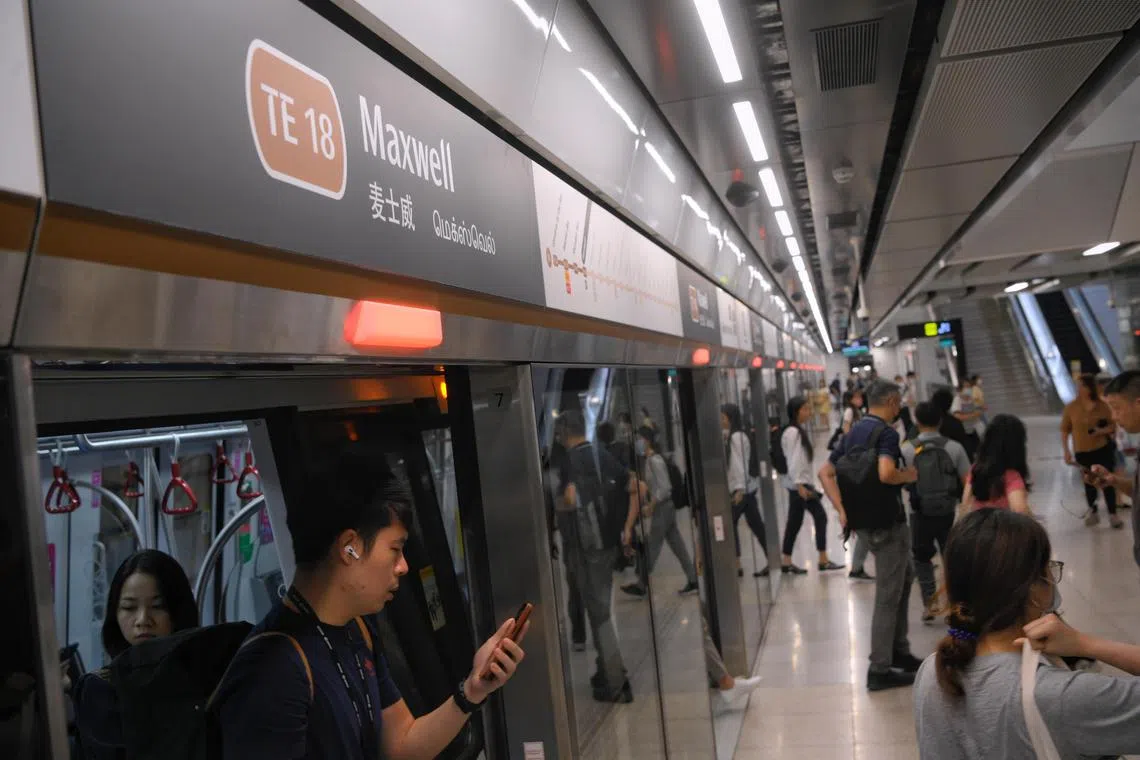TEL ridership nearly triples after opening of 11 new stations
Sign up now: Get ST's newsletters delivered to your inbox

By February, the two busiest TEL3 stations, excluding interchanges, were Maxwell station and Great World station.
ST PHOTO: MARK CHEONG
Follow topic:
SINGAPORE - The number of commuters using the Thomson-East Coast Line (TEL) has more than doubled in four months following the opening of 11 new stations last November
The Land Transport Authority (LTA) said average weekday ridership on Singapore’s sixth and newest MRT line rose from 60,000 in October 2022 to 160,000 in February 2023, with the opening of the 13.2km TEL Stage 3 (TEL3).
By February, the two busiest TEL3 stations, excluding interchanges, were Maxwell station, which serves offices and eateries in Tanjong Pagar and Chinatown, and Great World station, which has brought rail connectivity to the previously unserved River Valley and Kim Seng Road area.
More commuters are using the TEL3 interchange stations as well. These connect the TEL to the Downtown Line at Stevens station, the North-South Line (NSL) at Orchard and Marina Bay stations, the Circle Line at Marina Bay station, and to the East-West Line (EWL) and North East Line at Outram Park station.
LTA said the number of commuters travelling to and from Orchard and Outram Park stations has increased by around 10 per cent with the opening of TEL3 on Nov 13, 2022.
The first stage of the TEL opened three years ago
With TEL3, which runs from Stevens through Orchard and Outram Park to Gardens by the Bay, more than 180,000 households are now within a 10-minute walk of a TEL station.
However, overall MRT ridership has yet to bounce back fully from the Covid-19 pandemic, and the recovery has been uneven, given the shift towards more flexible work arrangements.
Major housing developments near the mothballed Mount Pleasant and Marina South TEL stations, as well as the upcoming Bayshore station, are also yet to be built.
Another 10 stations from Founders’ Memorial to Sungei Bedok,
In 2026, Woodlands North station will also be connected via an underground link to the upcoming Johor Bahru-Singapore Rapid Transit System Link.
The TEL is expected to serve 500,000 commuters daily when the 43km line is fully operational around 2025, and about one million riders a day eventually.
As some segments of the TEL run parallel with the NSL and EWL, the new line is expected to increase the resilience of the MRT network by lessening the load on Singapore’s two oldest rail lines. LTA could not confirm whether ridership on the other lines has been impacted.
Of the journeys that involve TEL3, 55 per cent saw commuters saving up to 10 minutes in travel time, while another 25 per cent saved riders more than 10 minutes, LTA said.
Commuters who use TEL3 also enjoy cost savings as some trip distances are reduced, LTA added. For instance, a train journey from Caldecott to Outram Park is 12 cents cheaper with TEL3.
Ms Amanda Gan, 24, who takes public transport from her home in Woodlands to her workplace in Grange Road, said TEL3 has shaved 20 minutes off her morning commute.
“I used to take the train to Orchard station and take a bus from there, but TEL lets me get off at Orchard Boulevard directly,” said the civil servant, adding that there are now more people, especially working adults, taking the TEL from Woodlands in the morning.
The only gripe she had was about train frequencies during peak hours, which is lower on the TEL than other MRT lines.
While the interval between trains was cut from nine to six minutes during off-peak hours after TEL3 opened, peak-hour train frequency has remained at five minutes.
LTA has said that it will review the train frequencies as ridership on the TEL increases.
Mr Tham Chen Munn, 47, who lives in Upper Thomson Road, said TEL3 has given him greater convenience and choice.
The business development director at traffic solutions firm PTV Asia-Pacific had expected the new stretch of rail to help ease traffic congestion on Upper Thomson Road, Lornie Road and the Central Expressway. But this has not been the case, based on his observations during evening peak hours over the last two weeks.
“It may be because the TEL is still new, and it takes time for people to get used to it,” Mr Tham said. He suggested that the authorities run more promotional campaigns to get more commuters to use the new line.
For Mr S.V. Gunalan, founder and director of Indian eatery chain Springleaf Prata Place, having a TEL station right outside one of his outlets has been a boon.
After Springleaf station opened in August 2021, his outlet in Springleaf Garden saw a 20 per cent to 25 per cent increase in sales.
This has since tapered to a daily sales boost of about 10 per cent to 15 per cent, but Mr Gunalan said he is content with that, given the manpower constraints he currently faces.
“The TEL is good not just because it is near our store, but also because of the connectivity it provides. My wife, who travels a lot, says it is a fantastic line for her to get everywhere.”


